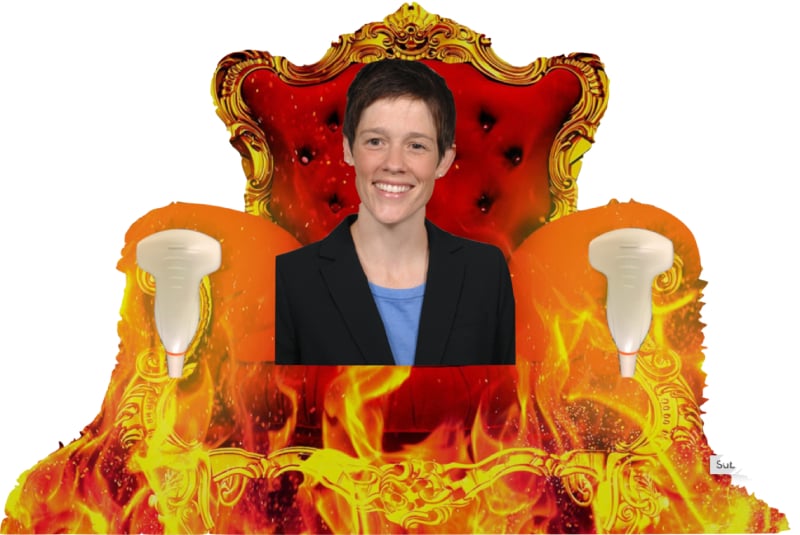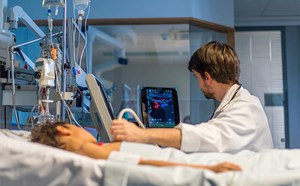
Sono Hot Seat with Lori Stolz on POCUS Billing and Revenue Infrastructure
Lori Stolz MD
University of Cincinnati
Questions posed by Stephen Alerhand MD
You took a job as Ultrasound Director at an institution with little billing, revenue, and quality assurance infrastructure. What was your sales pitch to departmental leadership as to why this was important? Were there any doubts or pushback? If so, how did you respond?
My department really knew that they had missed the boat with ultrasound. It is a historic institution and a great leader in emergency medicine. As this wave of Emergency Ultrasound had taken hold across the country, they’d fallen behind the crest. They committed as a department to recruiting an ultrasound director and creating an ultrasound program. Having no internal expertise, they did not know exactly what was needed at that point to have a successful ultrasound program. I think this set me up well to set a path of my own choosing. In retrospect, maybe I didn’t need to have such a sales pitch but I did. I came to the business manager with some of the earlier papers on how a comprehensive billing program could easily pay for itself and much of the needs of an emergency ultrasound program (Adhikari, 2014; Soremekun 2009). It seemed to work! They bought a middleware management system before I arrived and several new ultrasound machines, and I had the privilege of setting everything up from the ground up. The month I started, we had two departmental machines and the workflow included printing thermals, taping them to a piece of paper and scanning them into the EHR. Shortly thereafter, we had an unsolicited-orders workflow to a middleware, on-machine reporting, automatic transfer to the EHR of clinically-indicated studies, five machines and a billing program set up.
Can you walk us through your very first steps in moving forward with developing this infrastructure?
Before I arrived at Cincinnati, Dr. Frank Fernandez (ED physician and informaticist, now our hospital’s Chief Health Information Officer) was calling me on the phone asking me what I wanted the workflow to look like. I remember several long phone calls, often while driving in the car and moving across the country that summer, in which I detailed what our workflow had looked like at the University of Arizona and what I’d heard other people doing in other parts of the country. At one point he was like, “I really want you to think bigger. Like dreamworld big. What would the perfect workflow look like to you?” And that’s when we really got down to business. We now have a pretty slick workflow that functions really well for our needs. Our workflow can be completed start to finish on the machine with the record permanently in the chart, no further input from the physician. The report and images are in the patient chart, sent to billing with the correct CPT code and ready for QA. Simple workflow equals compliance equals billing. As time has gone on, we’ve improved the workflow even more to include automated emails if for some reason a piece of the documentation is not complete. I am trying to add a badge-in/badge-out feature and better patient barcode scanning options.
What were your biggest obstacles? How did you overcome those?
I think some things that helped overcome what others have found to be insurmountable obstacles with middleware set up was the right people on the team. We had several people from our hospital IT, clinical engineering and the interface team all talking to the software developers of the middleware. Instead of me trying to translate what I wanted from my layman’s terms, I had people on my team speaking the technical speak for me, which was incredibly helpful. Staying in touch with the team regularly and communicating clearly were the key pieces that made us successful.
Are you involved in the nitty-gritty details of finances and compensation as well, as in dealing with insurance companies, payers, etc.?
Not directly. I am usually working with one of our billing analysts in our department and another from the hospital, yes, we get very granular. We monitor the denial rates for various application types, monitor which payors are denying the codes and then adapt given the information that we have. Our billing department will look into patterns of denial with each payor so that we can better capture our billing. We usually have one or two modifications that we are working on at one time to better capture what we do. For instance, we weren’t billing the physician-performed ultrasound-guided IVs at all for several years. So we created a best practice plan for what documentation was needed with our hospital compliance department. Then we worked with our EHR folks to build the most efficient way for physicians to get this information into the chart with the ultrasound images archived in the medical record without duplicate documentation. Then we communicated to the physicians what steps they needed to follow (which was actually fewer clicks than they had been doing). Now we are at the stage where we are monitoring it, making sure that we are accurately capturing what we do, and making sure the physicians are following the workflow for the documentation correctly.
Do you foresee any challenges going forth with the capacity for POCUS to generate revenue?
The recent changes in EM billing does have the potential to change how POCUS is viewed as revenue generating. I don’t have a crystal ball to really say how this will turn out. Recently, the broader mission of remaining financially solvent while providing emergency care in an academic setting seems to be more of a struggle than it ever has been. I’m sure POCUS will be swept up in this struggle, for better or worse. At the very least, it can’t hurt to be a section/division that generates income for the hospital/medical group/institution undergoing financial stress.
What general, individualized, and/or concrete pearls would you provide to a recently graduated fellow looking to develop similar infrastructure in a new setting?
There are several good resources out there that map out how to set up a billing monitoring infrastructure and an ultrasound workflow that integrates billing. Some of these are manuscripts (examples) and the Ultrasound Program Management book. Beyond that, however, our national POCUS community is a fantastic resource. Chances are that someone in the emergency ultrasound sphere has tried to set up a POCUS workflow with your EHR, your machines, your middleware solution and can coach you on how to do it. The community as a whole is incredibly collegial and invested in helping each other and our specialty succeed. The ACEP EUS Industry subcommittee is a great place to stay on top of machine technologies that might affect your workflow within a department. Next, try to learn the language…just enough. You have to be able to understand what an HL7 message does and what DICOM really means. Understand that this is an entire field of study that others are expert in…so don’t be your own IT person! Build the team and rely on them for their skill set. When we do not rely on the trained professionals in this realm and try to instead do it ourselves, it can lead to a lot of dead ends and frustration. I find most of the issues others face come down to a breakdown in communication. Persistence is key. Also, when talking to folks who may not work in our clinical realm, relating a streamlined workflow to more efficient patient care, better billing capture and better compliance with documentation, you tend to get more traction.



